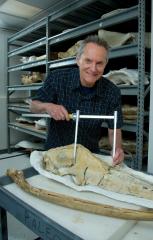SDAG monthly meeting
December 17 |
Location:
The San Diego Natural History Museum
1788 El Prado
San Diego, CA 92101
Directions:
Located in Balboa Park, the SDNHM is near the intersection of Park Boulevard and Village Place, just south of the San Diego Zoo.
Enter through the grand entrance on the North side, facing the large Morton Bay Fig tree.
|

6:00pm -
Social hour
|
SDAG Monthly Meeting
6:00pm - Social Hour
7:00pm - Dinner
8:00pm - Program
|
|

7:00pm
Dinner
|
Menu: Mexican Buffet (includes taco station with pollo asada, carne asada, veggies, etc.)
if pre-registered by the deadline, $5 extra if you did not make a reservation.
Click the SDAG member checkbox on the reservation form if you are a member.
|
Cost: $ 65.00 Member; Non-Member $ 75.00; Student $ 35.00
Reservations:
Make/Pay your reservation online by clicking the button below
by 6:00pm Wednesday, December 10
RESERVATIONS CANNOT BE ACCEPTED AFTER by 6pm Wednesday, December 10
(Please note beginning January 2024 all meeting reservations will require on-line pre-payment due to venue costs,
venue contracts, and loss of money due to no shows.)
IF YOU DO NOT PRE-PAY YOUR FOOD RESERVATION, WE CANNOT GUARANTEE YOU A MEAL.
|

8:00pm - Program
|
"150 years of Paleontology at the San Diego Natural History Museum"

Speaker: Tom Deméré
Tom Deméré attended San Diego State University (B.S., Geology), University of Southern California (M.S., Geology), and University of California
Los Angeles (Ph.D., Evolutionary Biology) and has worked at the San Diego Natural History Museum since 1979, where he is Curator of Paleontology.
Dr. Deméré is the author of numerous scientific and popular articles dealing with the paleontological history of southern California and the
evolutionary history of marine mammals. Tom also serves as Director of the Museum's Department of PaleoServices, which provides paleontological
assessment and mitigation services throughout the greater southern California region. The efforts of PaleoServices have resulted in the discovery
and recovery of thousands of fossil specimens that now reside in the Museum's research collections and public displays.
|
Upcoming SDAG meetings - 2025
December 17 - Traditional Holiday Celebration at the San Diego Natural History Museum with Tom Deméré on "150 years of Paleontology at the San Diego Natural History Museum"
Recordings of past meetings
Note: If the video or sound does not play, try using another web browser. Firefox and Chrome may work on some of the videos. MS Edge and Safari are most likely to work.
11/19/25 Joint Meeting with AEG Inland Empire Section - Eldon Gath on "San Joaquin Hills, Santa Ana Mountains, Puente Hills, and the Whittier fault: The final(?) grand theory of Orange County's tectonic geomorphic evolution"
10/15/2025 Todd Wirths on "Eocene Paleontology at Tourmaline Surfing Park, La Jolla"
8/20/2025 Dr. Mario Caputo on "Newly Discovered Tetrapod Bones, Insect Trace Fossils, & Eolian Adhesion Structures- Upper Pennsylvanian Wescogame Formation, Supai Group, Grand Canyon, Arizona"
7/16/2025 Rachel Maxwell on a survey of the Mojave-Sonoran Desert Springs and their sources. "Is this spring connected to that Aquifer?"
6/18/2025 Development of the western Hollywood Basin and Cheviot Hills, and newly identified blind thrust in Santa Monica Bay - Dr. Miles Kenney
5/14/2025 Landslide Stabilization - Dr. Sebastian Lobo-Guerrero (Audio is very quiet first few minutes.)
4/16/2025 Constraining Natural and Anthropogenic Controls on Base of Freshwater and Underground Source of Drinking Water (USDW) In Central San Joaquin Valley - Emily Imperato
4/16/2025 Examination of Middle Cambrian hyoliths from the Manuels River Formation of Avalonian southeastern Newfoundland - Nicolas Oliver
2/19/2025 A New Seismotectonic Framework for Active Faults in Metropolitan San Diego - Karl Mueller
8/21/2024 Upper Cretaceous through lower Eocene strata in San Diego: Messages for the end-Cretaceous impact, extinctions, and paleoclimates - Dr. Pat Abbott
5/15/2024 Exploring Iceland's Geological Wonders: From a Regional Perspective to a Hiking Expedition - Don Barrie & William Buckley
3/19/2024 Mighty Bad Land: A Perilous Expedition to Antarctica Reveals Clues to an Eighth Continent - Bruce Luyendyk
Meetings are usually scheduled for the 3rd Wednesday evening of the month.
Meeting information on this website is normally updated the second week of the month.
If you are a current SDAG member and are not getting e-mail announcements,
make sure the SDAG secretary has your correct e-mail address.
If you have any information, announcements, ads or suggestions for an upcoming newsletter, please submit it to
2025 SDAG Secretary.
Any news regarding upcoming events that may be of interest to the Association or news of your business can be submitted.
The submittal deadline for the next SDAG newsletter is the last Friday of the month.
|
|












